The Kilned Malt Market is estimated to be valued at USD 1.1 billion in 2025 and is projected to reach USD 1.4 billion by 2035, registering a compound annual growth rate (CAGR) of 3.0% over the forecast period.
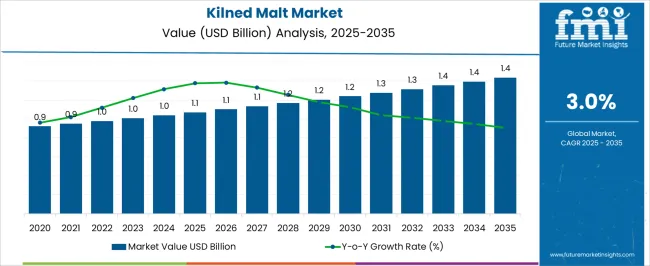
| Metric | Value |
|---|---|
| Kilned Malt Market Estimated Value in (2025 E) | USD 1.1 billion |
| Kilned Malt Market Forecast Value in (2035 F) | USD 1.4 billion |
| Forecast CAGR (2025 to 2035) | 3.0% |
The Kilned Malt market is experiencing steady growth due to the increasing demand for high-quality malt in brewing, distilling, and food industries. The current market scenario reflects a preference for products that provide consistent flavor profiles, enhanced fermentability, and improved extract yield.
Growth has been supported by rising consumption of craft beers, premium spirits, and malt-based foods across developed and emerging regions. Investments in modern malting facilities and advanced kilning technologies have enabled producers to maintain uniform product quality while meeting evolving regulatory and safety standards.
The market outlook is further strengthened by the increasing adoption of sustainable malting practices and the integration of traceability systems, which allow producers to track the origin and quality of raw materials As consumer preferences shift toward distinctive flavors and artisanal beverages, Kilned Malt is expected to remain a core ingredient, with significant opportunities emerging in specialty malts, premium brewing, and innovative food applications.
The kilned malt market is segmented by form, source, type, flavor, end use, and geographic regions. By form, kilned malt market is divided into Dry, Whole, Crushed, Flour, Pre-Ground, and Liquid. In terms of source, kilned malt market is classified into Barley, Wheat, Rey, Sorghum, Millet, and Other. Based on type, kilned malt market is segmented into Pale Malt, Vienna Malt, Munich Malt, and Aromatic Malt. By flavor, kilned malt market is segmented into Malty, Toasty, Bready, Biscuit, and Nutty. By end use, kilned malt market is segmented into Beer, Bakery, Alcoholic Beverages, Whiskey, and Animal Feed. Regionally, the kilned malt industry is classified into North America, Latin America, Western Europe, Eastern Europe, Balkan & Baltic Countries, Russia & Belarus, Central Asia, East Asia, South Asia & Pacific, and the Middle East & Africa.
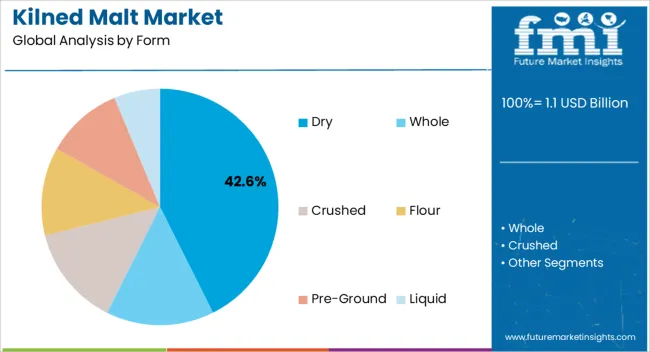
The Dry form segment is projected to account for 42.60% of the Kilned Malt market revenue in 2025, establishing it as the leading form. This dominance has been influenced by its longer shelf life, lower moisture content, and ease of storage and transportation compared with other forms. Adoption has been accelerated in large-scale breweries and distilleries where uniform quality and stability are critical for consistent production.
Dry malts provide predictable enzymatic activity and reduced risk of microbial contamination, which enhances process efficiency and product consistency. Furthermore, the reduced water content allows for flexible formulation in diverse brewing recipes and food applications.
The growing demand for premium and craft products has reinforced the importance of Dry form malts, while modern kilning processes have enabled producers to achieve desired flavor profiles and extract performance without compromising storage stability These factors collectively support the sustained leadership of the Dry form segment in the market.
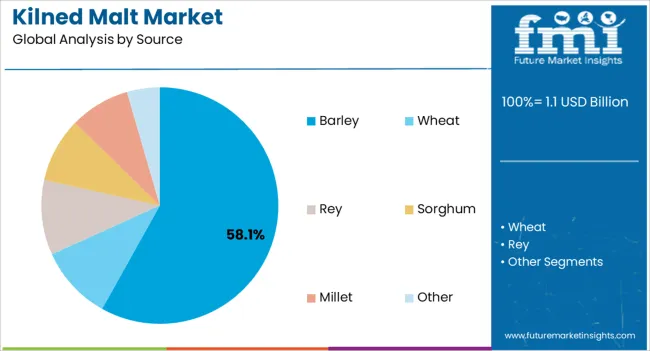
The Barley source segment is expected to hold 58.10% of the Kilned Malt market revenue in 2025, reflecting its dominance as the primary raw material. This position has been driven by the grain’s high enzyme content, consistent fermentable sugar yield, and suitability for a wide range of brewing and distilling applications.
Barley is preferred due to its ability to produce malts with uniform flavor, color, and aroma characteristics, which are essential for maintaining brand consistency. The cultivation of high-quality barley varieties and advancements in agricultural practices have further reinforced the reliability of this source.
Barley-based kilned malts have also been favored in traditional beer styles and premium craft beverages, where ingredient quality directly impacts sensory attributes As demand for authentic, high-quality brewing ingredients grows, barley will continue to underpin the majority of kilned malt production, ensuring stable market growth and segmental dominance.
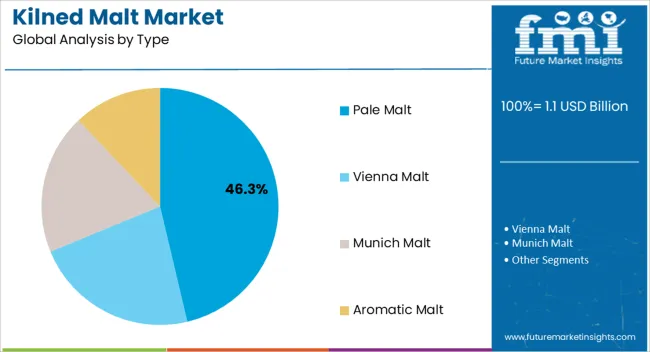
The Pale Malt type segment is projected to hold 46.30% of the Kilned Malt market revenue in 2025, establishing it as the leading malt type. This predominance is being driven by its versatility in brewing, where it serves as a base malt for a wide range of beer styles. Pale malts provide a favorable balance of fermentable sugars, enzymatic activity, and flavor, which supports consistent production and desirable color profiles.
The growth of craft brewing and premium beer consumption has further fueled demand, as brewers rely on Pale Malts for both traditional and innovative recipes. Enhanced kilning techniques have improved flavor consistency, aroma retention, and extract yield, reinforcing its preference among commercial and artisanal producers.
Additionally, Pale Malts are compatible with various adjunct ingredients, allowing for flexibility in product development These attributes collectively ensure the sustained leadership of the Pale Malt type segment in the Kilned Malt market.
Malts are the kernels of the grain, usually barley that are allowed to sprout and grow for a few days and then heated to stop the germination. Kilned malts are prepared by heating with the intention of drying them out rather than heating with the water. The moisture content of the grains of the kilned malt is brought to 3% to 5%. Some of the kilned malts are prepared at low temperature while some are prepared at high temperature, ranging between 35°C to 100°C.
This wide range of temperature is the required to get the balance between diastatic power and flavor of the kilned malt. The range of flavors can be achieved such as toasty, bready or simply malty. The flavor becomes more pronounced with the increase in the temperature at which kilned malt is prepared. Kilned malts are not used for their enzyme content but for the characteristics that impart special color and flavor in end product.
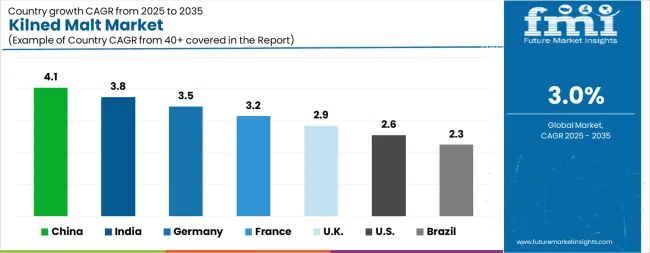
| Country | CAGR |
|---|---|
| China | 4.1% |
| India | 3.8% |
| Germany | 3.5% |
| France | 3.2% |
| UK | 2.9% |
| USA | 2.6% |
| Brazil | 2.3% |
The Kilned Malt Market is expected to register a CAGR of 3.0% during the forecast period, exhibiting varied country level momentum. China leads with the highest CAGR of 4.1%, followed by India at 3.8%. Developed markets such as Germany, France, and the UK continue to expand steadily, while the USA is likely to grow at consistent rates. Brazil posts the lowest CAGR at 2.3%, yet still underscores a broadly positive trajectory for the global Kilned Malt Market. In 2024, Germany held a dominant revenue in the Western Europe market and is expected to grow with a CAGR of 3.5%. The USA Kilned Malt Market is estimated to be valued at USD 385.9 million in 2025 and is anticipated to reach a valuation of USD 496.3 million by 2035. Sales are projected to rise at a CAGR of 2.6% over the forecast period between 2025 and 2035. While Japan and South Korea markets are estimated to be valued at USD 56.7 million and USD 36.7 million respectively in 2025.
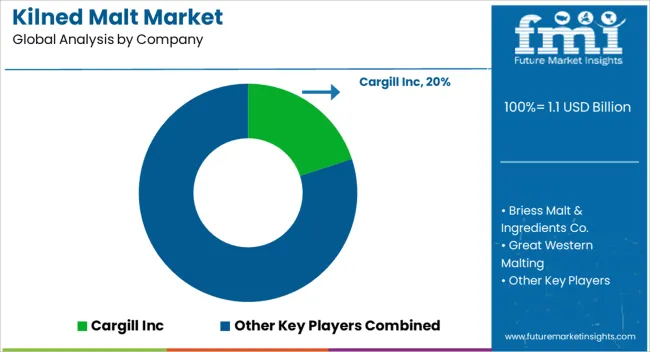
| Item | Value |
|---|---|
| Quantitative Units | USD 1.1 Billion |
| Form | Dry, Whole, Crushed, Flour, Pre-Ground, and Liquid |
| Source | Barley, Wheat, Rey, Sorghum, Millet, and Other |
| Type | Pale Malt, Vienna Malt, Munich Malt, and Aromatic Malt |
| Flavor | Malty, Toasty, Bready, Biscuit, and Nutty |
| End Use | Beer, Bakery, Alcoholic Beverages, Whiskey, and Animal Feed |
| Regions Covered | North America, Europe, Asia-Pacific, Latin America, Middle East & Africa |
| Country Covered | United States, Canada, Germany, France, United Kingdom, China, Japan, India, Brazil, South Africa |
| Key Companies Profiled | Cargill Inc, Briess Malt & Ingredients Co., Great Western Malting, Rahr Malting Co., and Gladfield Malting Company |
The global kilned malt market is estimated to be valued at USD 1.1 billion in 2025.
The market size for the kilned malt market is projected to reach USD 1.4 billion by 2035.
The kilned malt market is expected to grow at a 3.0% CAGR between 2025 and 2035.
The key product types in kilned malt market are dry, whole, crushed, flour, pre-ground and liquid.
In terms of source, barley segment to command 58.1% share in the kilned malt market in 2025.






Our Research Products

The "Full Research Suite" delivers actionable market intel, deep dives on markets or technologies, so clients act faster, cut risk, and unlock growth.

The Leaderboard benchmarks and ranks top vendors, classifying them as Established Leaders, Leading Challengers, or Disruptors & Challengers.

Locates where complements amplify value and substitutes erode it, forecasting net impact by horizon

We deliver granular, decision-grade intel: market sizing, 5-year forecasts, pricing, adoption, usage, revenue, and operational KPIs—plus competitor tracking, regulation, and value chains—across 60 countries broadly.

Spot the shifts before they hit your P&L. We track inflection points, adoption curves, pricing moves, and ecosystem plays to show where demand is heading, why it is changing, and what to do next across high-growth markets and disruptive tech

Real-time reads of user behavior. We track shifting priorities, perceptions of today’s and next-gen services, and provider experience, then pace how fast tech moves from trial to adoption, blending buyer, consumer, and channel inputs with social signals (#WhySwitch, #UX).

Partner with our analyst team to build a custom report designed around your business priorities. From analysing market trends to assessing competitors or crafting bespoke datasets, we tailor insights to your needs.
Supplier Intelligence
Discovery & Profiling
Capacity & Footprint
Performance & Risk
Compliance & Governance
Commercial Readiness
Who Supplies Whom
Scorecards & Shortlists
Playbooks & Docs
Category Intelligence
Definition & Scope
Demand & Use Cases
Cost Drivers
Market Structure
Supply Chain Map
Trade & Policy
Operating Norms
Deliverables
Buyer Intelligence
Account Basics
Spend & Scope
Procurement Model
Vendor Requirements
Terms & Policies
Entry Strategy
Pain Points & Triggers
Outputs
Pricing Analysis
Benchmarks
Trends
Should-Cost
Indexation
Landed Cost
Commercial Terms
Deliverables
Brand Analysis
Positioning & Value Prop
Share & Presence
Customer Evidence
Go-to-Market
Digital & Reputation
Compliance & Trust
KPIs & Gaps
Outputs
Full Research Suite comprises of:
Market outlook & trends analysis
Interviews & case studies
Strategic recommendations
Vendor profiles & capabilities analysis
5-year forecasts
8 regions and 60+ country-level data splits
Market segment data splits
12 months of continuous data updates
DELIVERED AS:
PDF EXCEL ONLINE
Malt Sprouts Market Size and Share Forecast Outlook 2025 to 2035
Malted Rye Flour Market Size and Share Forecast Outlook 2025 to 2035
Malted barley flour Market Size and Share Forecast Outlook 2025 to 2035
Malt Beverage Market Analysis - Size, Share, and Forecast Outlook 2025 to 2035
Malted Milk Market Size and Share Forecast Outlook 2025 to 2035
Malt Ingredients Market Analysis by Raw Material, Product Type, Grade, End-use, and Region through 2035
Malt Market Trends and Forecast 2025 to 2035
Analysis and Growth Projections for Maltodextrin Business
Maltitol Market Analysis by form, end use industry and by region – Growth, trends and forecast from 2025 to 2035
Malted Milk Powder Market Trends - Growth & Industry Forecast 2025 to 2035
Malted Wheat Flour Market
Isomalt Market Analysis - Size, Share, and Forecast 2025 to 2035
Isomalt Industry in Japan – Growth & Industry Trends 2025 to 2035
Isomalt Industry Analysis in Western Europe – Size, Share & Forecast 2025 to 2035
Isomaltulose Market Growth - Size, Trends & Forecast 2025 to 2035
Isomalto-oligosaccharide Market Analysis by Form, Source, End-use Application and Region through 2035
Dry Malt Products Market
Wheat Malt Market Size and Share Forecast Outlook 2025 to 2035
Hopped Malt Extract Market Analysis by End Use, Type, Source, and Region Through 2025 to 2035
Europe Malt Extract Market Growth & Demand Forecast 2017-2027

Thank you!
You will receive an email from our Business Development Manager. Please be sure to check your SPAM/JUNK folder too.
Chat With
MaRIA